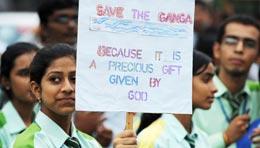Ganges project is a sign of India’s revival

Since time immemorial, Hindus have cremated their dead on the banks of the Ganges River believing in the promise that the goddess of the river will carry the ashes to escape the constant cycle of reincarnation.
Today this sacred Indian waterway also sees three hundred million liters of raw sewage mixed with industrial pollutants are dumped in the Ganges daily.
The 2,525-km-long river, one of the worlds most polluted, is at the centre of a promise made by India’s newly minted leader Narendra Modi to clean it up as a symbol of India’s renewal.
Last week, Prime Minister Modi's pet Clean Ganges project received a boost with the inking of an agreement between India and Canada to clean up the river, one of the most heavily used in the world.
The Ministry of Water Resources, River Development and Ganges Rejuvenation inked a memorandum of understanding with India-Canada Centre for Innovative Multidisciplinary Partnerships to Accelerate Community Transformation and Sustainability (IC-IMPACTS) for collaborative water research with Indian institutions and industry partners to clean up the Ganga.
Under the partnership, existing Canadian technologies in waste-water treatment, water quality monitoring and management, and water reduction and waste-water reuse for sectors such as the pulp and paper industry would also be highlighted, said an official statement from the Canadian High COmmission here.
Canada's Minister of International Trade Ed Fast and India's Minister of Science and Technology Jitendra Singh Wednesday launched a call for joint R & D projects under the Canada-India Science and Technology Cooperation Agreement.
India's Department of Science and Technology (DST) would collaborate directly with the IC-IMPACTS.
"This new call for proposals will promote scientific collaboration between Indian and Canadian scientists through joint R & D projects in safe and sustainable infrastructure and integrated water management. Successful joint research projects are expected to lead to solutions to challenges that affect the quality of life of millions of people in Indian and Canadian communities," said the statement.
Minister Fast's six-day, three-city trade mission to India coincides with an intensive week of high-level engagement with India with Canada's Minister for Foreign Affairs John Baird, Minister for National Revenue Kerry-Lynne Findlay and Premier of the province of British Columbia Christy Clark visiting India.
IC-IMPACTS is led on the Canadian side by the universities of British Columbia, Alberta and Toronto and is funded through the Government of Canada's Networks of Centres of Excellence programme.
The plan comes just as India’s Supreme Court said heads must roll for the systemic failure to clean the Ganges and that people on the ground were more interested in bribe than in their task.
"So many heads should roll for the failure to implement the plan. It was not being allowed to be done for corrupt means. This is happening because some people who are entrusted to do the work are not doing it. They are not doing it not because they don't like it but are being bribed," said a bench of Justice T.S. Thakur, Justice Adarsh Kumar Goel and Justice R. Banumathi.
The strong observation from the bench came as it was told that since 2007 only one sewage treatment plant was set up in Dehradun and repeated reminders from the Central Pollution Control Board to the State Pollution Control Boards in Uttar Pradesh, Bihar and West Bengal to act against grossly polluting industries have fallen on deaf ears.
"It has not happened for so many years. If it goes on like that it (Ganga cleaning) may not happen in our lifetime. There has to be (fixing of) accountability," said Justice Thakur.
The Ganges is the largest river in India with an extraordinary religious importance for Hindus. Situated along its banks are some of the world's oldest inhabited cities like Varanasi and Patna. It provides water to about 40% of India's population across 11 states, serving an estimated population of 500 million people or more, which is larger than any other river in the world.
The Ganges river basin is also one of the most fertile and densely populated regions in the world and covers an area of 1,080,000 km2 (400,000 square miles). The river flows through 29 cities with population over 100,000; 23 cities with population between 50,000 and 100,000, and about 48 towns.
A large proportion of the waste in the Ganges is from this population through domestic usage like bathing, laundry and public defecation.
Countless tanneries's chemical plants, textile mills, distilleries, slaughterhouses, and hospitals contribute to the pollution of the Ganges by dumping untreated waste into it.[8] Industrial effluents are about 12% of the total volume of effluent reaching the Ganges. Although a relatively low proportion, they are a cause for major concern because they are often toxic and non-biodegradable.
During festival seasons, over 70 million people bathe in the Ganges over a few weeks to cleanse themselves from their sins. Some materials like food, waste or leaves are left in the Ganges for ritualistic reasons.









